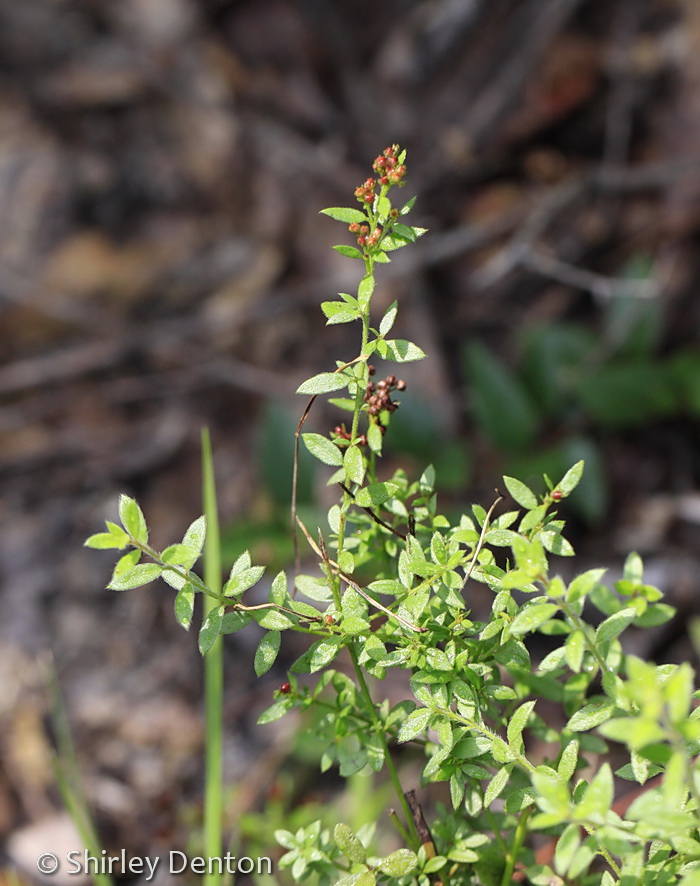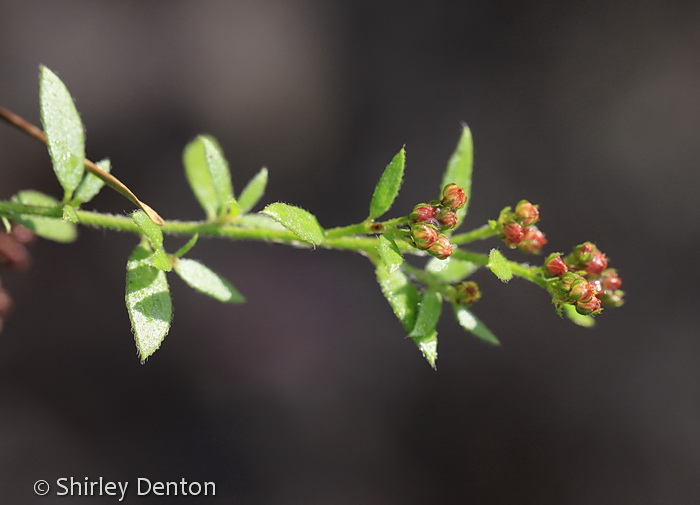Difference between revisions of "Lechea minor"
Krobertson (talk | contribs) |
|||
| Line 24: | Line 24: | ||
==Description== | ==Description== | ||
<!-- Basic life history facts such as annual/perrenial, monoecious/dioecious, root morphology, seed type, etc. --> | <!-- Basic life history facts such as annual/perrenial, monoecious/dioecious, root morphology, seed type, etc. --> | ||
| − | This species can be frequent where it occurs | + | This species can be frequent where it occurs. <ref name="FSU Herbarium">Florida State University Robert K. Godfrey Herbarium database. URL: [http://herbarium.bio.fsu.edu http://herbarium.bio.fsu.edu]. Last accessed: June 2014. Collectors: Robert K. Godfrey, Kevin Oakes, and R. Komarek. States and Counties: Florida: Leon and Franklin. Georgia: Baker, Grady, and Thomas.</ref> |
"Perennial herbs with tap roots and basal rosettes of procumbent, leafy stems late in the season; early stems erect, several from a crown, freely branched above, appressed or spreading pubescent. Leaves opposite, subopposite, whorled or subverticillate on lower part of stem, usually alternate above, usually short-petiolate; leaves of the winter rosettes usually whorled or subverticillate. Inflorescence of scroppoid cymes or racemes in a panicle or theyrse. Sepals 5, outer 2 linear, inner 3 elliptic to ovate; petals 3, reddish or maroon, usually shorter than the sepals; stamens mostly 5-15; stigmas 3, red, plumose. Capsule 1-3 seeded; seeds reddish brown or brown ca. 1 mm long." <ref name=r> Radford, Albert E., Harry E. Ahles, and C. Ritchie Bell. Manual of the Vascular Flora of the Carolinas. 1964, 1968. The University of North Carolina Press. 720-1. Print. </ref> | "Perennial herbs with tap roots and basal rosettes of procumbent, leafy stems late in the season; early stems erect, several from a crown, freely branched above, appressed or spreading pubescent. Leaves opposite, subopposite, whorled or subverticillate on lower part of stem, usually alternate above, usually short-petiolate; leaves of the winter rosettes usually whorled or subverticillate. Inflorescence of scroppoid cymes or racemes in a panicle or theyrse. Sepals 5, outer 2 linear, inner 3 elliptic to ovate; petals 3, reddish or maroon, usually shorter than the sepals; stamens mostly 5-15; stigmas 3, red, plumose. Capsule 1-3 seeded; seeds reddish brown or brown ca. 1 mm long." <ref name=r> Radford, Albert E., Harry E. Ahles, and C. Ritchie Bell. Manual of the Vascular Flora of the Carolinas. 1964, 1968. The University of North Carolina Press. 720-1. Print. </ref> | ||
| Line 34: | Line 34: | ||
===Habitat=== <!--Natural communities, human disturbed habitats, topography, hydrology, soils, light, fire regime requirements for removal of competition, etc.--> | ===Habitat=== <!--Natural communities, human disturbed habitats, topography, hydrology, soils, light, fire regime requirements for removal of competition, etc.--> | ||
| − | This species can be found in sandy soils in open fields, open bogs, and longleaf pine forests | + | This species can be found in sandy soils in open fields, open bogs, and longleaf pine forests. <ref name="FSU Herbarium"/> It also occurs in human disturbed areas such as powerline corridors and in old roadbeds. <ref name="FSU Herbarium"/> Associated species include Longleaf pine and wiregrass. <ref name="FSU Herbarium"/> |
<!--===Phenology===--> <!--Timing off flowering, fruiting, seed dispersal, and environmental triggers. Cite PanFlora website if appropriate: http://www.gilnelson.com/PanFlora/ --> | <!--===Phenology===--> <!--Timing off flowering, fruiting, seed dispersal, and environmental triggers. Cite PanFlora website if appropriate: http://www.gilnelson.com/PanFlora/ --> | ||
| Line 43: | Line 43: | ||
Several short-lived perennial forbs also have a seed bank persistent for at least several years.<ref>Platt, W. J., S. M. Carr, et al. (2006). "Pine savanna overstorey influences on ground-cover biodiversity." Applied Vegetation Science 9: 37-50.</ref> | Several short-lived perennial forbs also have a seed bank persistent for at least several years.<ref>Platt, W. J., S. M. Carr, et al. (2006). "Pine savanna overstorey influences on ground-cover biodiversity." Applied Vegetation Science 9: 37-50.</ref> | ||
===Fire ecology=== <!--Fire tolerance, fire dependence, adaptive fire responses--> | ===Fire ecology=== <!--Fire tolerance, fire dependence, adaptive fire responses--> | ||
| − | Can grow in areas that are annually burned | + | Can grow in areas that are annually burned. <ref name="FSU Herbarium"/> |
<!--===Pollination===--> | <!--===Pollination===--> | ||
<!--===Use by animals===--> <!--Herbivory, granivory, insect hosting, etc.--> | <!--===Use by animals===--> <!--Herbivory, granivory, insect hosting, etc.--> | ||
| Line 55: | Line 55: | ||
==References and notes== | ==References and notes== | ||
| − | |||
Revision as of 14:43, 29 July 2016
| Lechea minor | |
|---|---|

| |
| Photo by Shirley Denton (Copyrighted, use by photographer’s permission only), Nature Photography by Shirley Denton | |
| Scientific classification | |
| Kingdom: | Plantae |
| Division: | Magnoliophyta - Flowering plants |
| Class: | Magnoliopsida – Dicotyledons |
| Order: | Violales |
| Family: | Cistaceae |
| Genus: | Lechea |
| Species: | L. minor |
| Binomial name | |
| Lechea minor L. | |

| |
| Natural range of Lechea minor from USDA NRCS Plants Database. | |
Common name: thymeleaf pinweed
Contents
Taxonomic notes
Synonym: Lechea thymifolia Michaux
Description
This species can be frequent where it occurs. [1]
"Perennial herbs with tap roots and basal rosettes of procumbent, leafy stems late in the season; early stems erect, several from a crown, freely branched above, appressed or spreading pubescent. Leaves opposite, subopposite, whorled or subverticillate on lower part of stem, usually alternate above, usually short-petiolate; leaves of the winter rosettes usually whorled or subverticillate. Inflorescence of scroppoid cymes or racemes in a panicle or theyrse. Sepals 5, outer 2 linear, inner 3 elliptic to ovate; petals 3, reddish or maroon, usually shorter than the sepals; stamens mostly 5-15; stigmas 3, red, plumose. Capsule 1-3 seeded; seeds reddish brown or brown ca. 1 mm long." [2]
"Stems appressed pubescent, 2-7 dm tall with mostly spreading ascending branches; principal stems 1-2 mm in diam. Leaves oblong to elliptic, spreading to spreading-ascending, 6-12 mm long, 1-3 mm wide, glabrous above, ciliate, pubescent beneath mostly on the midrib and near the margins; leaf arrangement similar to no. , but opposite and whorled arrangement often higher into the inflorescence; petioles ca. 1 mm long. Inner sepals shorter than the capsule, 1-1.5 mm long, outer slightly longer. Capsule ellipsoid 1.2-1.7 mm long, 0.7-1 mm broad, 3-seeded." [2]
Distribution
Ecology
Habitat
This species can be found in sandy soils in open fields, open bogs, and longleaf pine forests. [1] It also occurs in human disturbed areas such as powerline corridors and in old roadbeds. [1] Associated species include Longleaf pine and wiregrass. [1]
Seed dispersal
According to Kay Kirkman, a plant ecologist, this species disperses by being consumed by vertebrates (being assumed). [3]
Seed bank and germination
Several short-lived perennial forbs also have a seed bank persistent for at least several years.[4]
Fire ecology
Can grow in areas that are annually burned. [1]
Conservation and management
Cultivation and restoration
Photo Gallery
Lechea minor Photo by Shirley Denton
(Copyrighted, use by photographer’s permission only)
References and notes
- ↑ 1.0 1.1 1.2 1.3 1.4 Florida State University Robert K. Godfrey Herbarium database. URL: http://herbarium.bio.fsu.edu. Last accessed: June 2014. Collectors: Robert K. Godfrey, Kevin Oakes, and R. Komarek. States and Counties: Florida: Leon and Franklin. Georgia: Baker, Grady, and Thomas.
- ↑ 2.0 2.1 Radford, Albert E., Harry E. Ahles, and C. Ritchie Bell. Manual of the Vascular Flora of the Carolinas. 1964, 1968. The University of North Carolina Press. 720-1. Print.
- ↑ Kay Kirkman, unpublished data, 2015.
- ↑ Platt, W. J., S. M. Carr, et al. (2006). "Pine savanna overstorey influences on ground-cover biodiversity." Applied Vegetation Science 9: 37-50.
